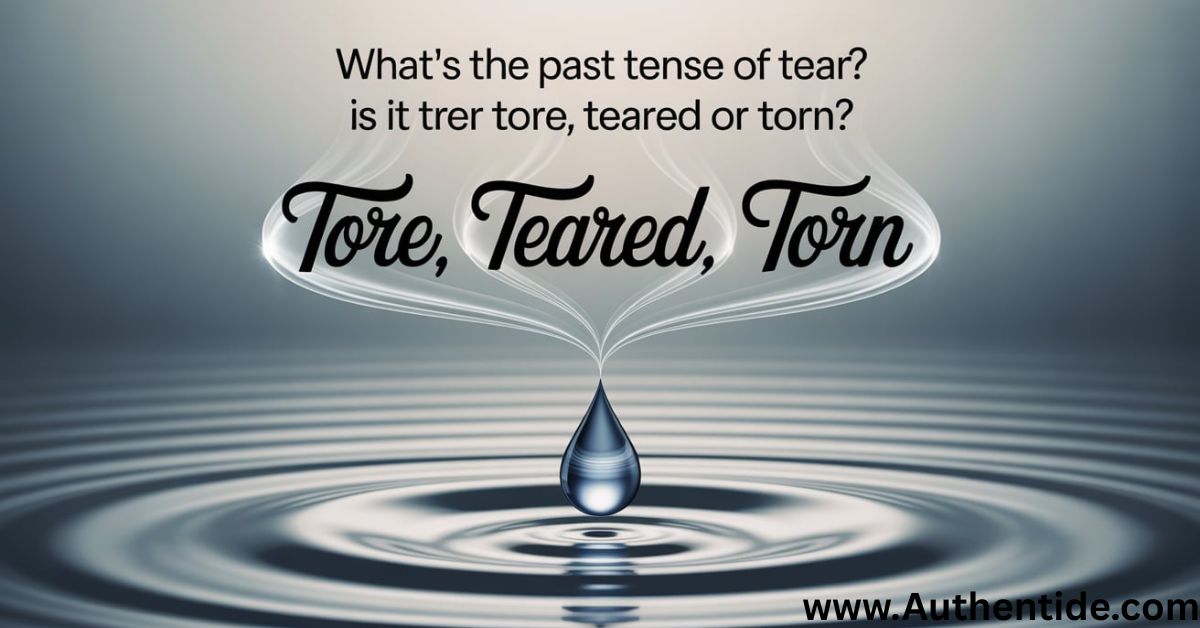The past tense of tear can be surprisingly tricky—even for native speakers. Why? Because “tear” doesn’t behave like regular verbs, and depending on its meaning, you might find yourself torn (no pun intended) between saying tore, torn, or teared. It doesn’t help that teared is also the past tense of a completely different “tear”—as in crying. Confusing, right?
Think about it. You’re writing an email or crafting a story, and you pause: “She… tore the paper? Or was it torn?” Maybe you even wonder, “Could it be torn?” Don’t worry—you’re not alone. This is one of those classic English verb traps where context is everything, and knowing which form fits matters a lot.
In this guide, you’ll not only learn the correct past tense of tear, but also when to use tore, torn, or teared—with real-life examples, grammar tips, and even pronunciation guidance. We’ll explore the meanings, verb conjugations, and correct usage of this irregular verb in both emotional and physical contexts.
Why Is There Confusion?
English is riddled with irregular verbs, and “tear” is one of them. Unlike regular verbs, where you just add “-ed,” the verb tear transforms into tore (past) and torn (past participle). But then comes “teared,” which—despite sounding like a past form of tearing something—is actually used when referring to crying or shedding tears.
It doesn’t help that tear is a homograph—a word spelled the same but pronounced differently based on meaning:
- Tear (rhymes with “care”) — to rip or pull apart
- Tear (rhymes with “fear”) — a drop of liquid from the eye
This double meaning makes it even more important to understand context.
What Does the Word “Tear” Mean?
The verb tear can carry several meanings depending on its use:
- To rip or pull apart (e.g., “He will tear the paper.”)
- To move quickly or forcefully (e.g., “She tore through the hallway.”)
- To shed tears or cry (e.g., “He teared up during the speech.”)
Understanding these uses is the first step in figuring out the correct verb form.
The Past Tense of “Tear”
Let’s break it down clearly:
- Tore is the simple past tense of tear when referring to pulling or ripping something.
- Torn is the past participle of tear used with auxiliary verbs like have or had.
- Teared is used only when referring to crying or tears, not ripping.
🔊 Pronunciation of “Tear,” “Tore,” “Torn,” and “Teared”
Here’s how each form sounds:
| Word | Pronunciation | Context |
|---|---|---|
| Tear | /tɛər/ or /tɪər/ | Ripping vs. Crying |
| Tore | /tɔːr/ | Simple Past (Ripping) |
| Torn | /tɔːrn/ | Past Participle (Ripping) |
| Teared | /tɪərd/ | Crying (Past Tense) |
Use the /tɛər/ sound for ripping, and /tɪər/ for tears from your eyes. It’s a subtle but crucial distinction.
A Simple Table Showing the Present, Past, and Future Tense of “Tear”
| Tense | Verb Form | Example |
|---|---|---|
| Present | tear | I always tear the wrapping paper. |
| Simple Past | tore | Yesterday, she tore the envelope open. |
| Past Participle | torn | The poster has been torn to pieces. |
| Future | will tear | I will tear the tag off later. |
Examples of “Tear,” “Tore,” “Torn,” and “Teared” in Sentences
Let’s look at real-world examples to clear things up.
📧 Email Example – Using “Tore”
Subject: Urgent: Delivery Issue
Hi Karen,
Just letting you know that the packaging was damaged upon arrival. I noticed the courier tore one corner to access the label. Could you please file a report with the carrier?
Thanks,
Jake
✍️ Narrative Example – Using “Torn”

Maria stared at the photo, now torn and crumpled in her hands. She hadn’t meant to destroy it, but the emotions took over. She had loved him, after all.
😢 Sympathetic Email Example – Using “Teared”
Subject: That Was a Powerful Speech
Hi Mark,
I just wanted to say your words at the fundraiser were incredibly moving. I actually teared up when you mentioned your father’s battle with cancer. Thank you for sharing your story.
Best,
Alyssa
Tear (The Present Tense)
The present tense of tear is used to describe actions happening right now or regularly.
“I always tear open my mail like a kid at Christmas.”
Tore (The Simple Past Tense)
Use tore when referring to something that happened in the past and is now over.
“She tore her dress on the fence yesterday.”
Torn (The Past Participle)
Torn is the past participle of tear, and it’s used with has, have, or had.
“The page has been torn out of the book.”
“He had torn his jeans before arriving.”
Teared (The Past Tense of Tear for Crying or Shedding Tears)
This form is only correct when talking about crying.
“He teared up during the farewell speech.”
“They teared silently during the emotional film.”
Synonyms for “Tear,” “Tore,” “Torn,” and “Teared”
Synonyms for “Tear” (Present Tense)

- Rip
- Split
- Shred
- Slash
Synonyms for “Tore” (Simple Past Tense)
- Ripped
- Split
- Lacerated
Synonyms for “Torn” (Past Participle)
- Ripped apart
- Mangled
- Frayed
- Severed
Synonyms for “Teared” (Crying)
- Cried
- Wept
- Sobbed
- Got emotional
Origins of the Word “Tear”
The verb tear (meaning to rip) comes from Old English teran, which meant to pull apart or rend by force. The crying version has a different origin—Old English tēar, from Proto-Germanic roots. Both forms evolved separately despite being spelled the same today.
The Noun “Tear” (The Fluid Drop from the Eye)
As a noun, tear refers to that salty drop from the eye. It has its own pronunciation (/tɪər/) and usage.
“A single tear rolled down her cheek.”
The Verb “Tear” (To Rend or Pull Apart by Force)
This is the main focus when we talk about tear past tense.
“Please don’t tear the contract in anger.”
The Verb “Tear” (To Weep or Cry)
Yes, “tear” can also mean to cry. In this case, the past tense is teared, and it’s used when discussing emotions.
“She teared up the moment she saw the tribute video.”
The Noun “Tear” (A Tearing or Laceration)
This version refers to a rip or a break in something—clothes, paper, skin, etc.
“There was a small tear in the upholstery.”
The Verb “Tear” (To Move Noisily)
Rare but vivid, this usage describes fast, reckless movement.
“He tore down the hallway like a storm.”
The Most Important Paragraph
When choosing the correct form of “tear” in your writing, always identify the meaning first—Are you talking about ripping? Crying? Past or present? Then apply the proper verb tense:
- Use tore for simple past (ripping)
- Use torn as a past participle (ripping)
- Use teared ONLY for crying/emotional context
Think: “He tore the paper,” “The paper was torn,” and “He teared up during the movie.” That tiny distinction changes the entire meaning of your sentence.
A Final Look at the Past Tense of “Tear
So, what’s the past tense of tear? If you’re talking about ripping or pulling apart, use tore (past) and torn (past participle). If you’re talking about crying, use teared. It all depends on the context and meaning behind your sentence.
The next time you’re stuck between tore, torn, or teared, just remember:
“She tore the letter, it was torn in anger, and later, she teared up with regret.”
Simple, right?

Your go-to place for smart synonyms and celebrity updates. Muhammad Hassan Abid is dedicated to creating useful, engaging content that informs, inspires, and truly serves your curiosity

